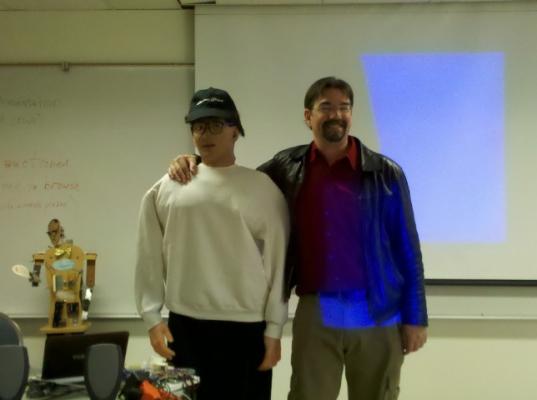January 14, 2012
Martin K.
Presentation : Robotic Exoskeletons
Martin gave a short presentation about his senior project on robotic exoskeletons. He is focusing on building a single arm, that will be attached with a counterweighted backpack. He's planning to use force/pressure sensors to control a linear actuator with 2” stroke and 250lb load rating.
Suggestions from the group include using a resistive flex sensor (i.e. http://www.sparkfun.com/products/10264) to control the actuator, and a focus on safety issues, such as kill switches and limit switches.
The topic then moved on to some videos of other exoskeletons, and then to videos of PETMAN and BigDog from Boston Dynamics.
Thomas M.
Class : From Elvis to Melvis, or How to Hack a WowWee Robotics' Alive Elvis
Introduction
What's inside Elvis? A motherboard, sound board, A/D boards, H bridges, sensor boards, power, emitter/detector boards, motors/gears, and more.
Hardware
The WowWee servo has a motor and trimpot, making a cheap servo. However, a standard servo also contains feedback and a control board. The WowWee servo requires H-bridges, A/D boards, and microcontrollers to know and control the position of the servo. There are 8 servos in the head and 2 in the base.
One of the most difficult aspects was understanding and hacking, um, rather reverse engineering, the A/D board. Head tilt – forward/back and side/side – uses encoder boards.
Getting the mouth to sync
After first trying control with an Arduino, it wasn't working. Next, he tried swapping out the standard servo guts and put in place of the WowWee servo's, but it was slow and the boards were getting hot due to 9V being used. The last resort then was using a standard servo. Also, he used a “Scary Terry” board that converts the incoming sound into a pulse that the servo understands. It worked!
As of today, he is able to control:
- eyes : up/down, left/right, close/open
- neck : turns left/right
- mouth : syncs with voice
Currently, they have designed a custom board with the Basic Stamp2 that plugs into the back of the head. However, it can only control 7 motions, so they plan to update to a Propeller or PIC to control all motions.
What's the future of Melvis? Goals are to get the eyes to blink independently, get the neck tilt to work, integrate a Kinect for “sight.” Also, he would like to make it walk... one day.
Business Meeting
Old / New Business
We voted to have dues of $10 yearly optional for those who can/want to donate for trophies, web/domain renewals.
Monies can be given to our treasurer Ron.
Upcoming Classes (11:00 – 12:00)
| Month | Class | Presenter |
| February 11 | EagleCAD : How to design and have your own boards made - Part 1 | Bill |
| March 10 | EagleCAD : How to design and have your own boards made - Part 2 | Bill |
| April 14 | Intro to Parallax's Propeller Chip | Stephen |
| May 12 | Introduction to PIC Microntrollers |
Upcoming Competetions:
February 11 - Fire fighting competition
We will have many student teams competing from Mt. Sac (College).
Very nicely documented competition rules and lots of other great demos can be found here: http://profmason.com/
March 10 - Sumo-Bot competition
June - Hallway contest
Choose your method of dead reckoning, wall following, odometry, etc. No landmarks may be added to the hallway. Alex will update with additional rules in the future.
July - Bipedal robot competition
Gene will put together some guidelines based on the RoboGames (http://robogames.net/rules/biped.php). Maybe also have a freestyle competition.
December – Annual Robot Talent Show
Show and Tell
Maya
Showed off her ladybug robot. She learned quite a bit from it, according to her nodding approval. It can also be hacked to use the PICAXE chip.
Bill
Showed us a power supply board he made using EagleCAD. The power supply board can be used
as a breakout board from regular inexpensive PC power supplies. He offered to make boards if there is enough interest to cover the cost.
Rainer
Brought his Maple board, it is a 72MHz ARM Cortex M3 chip, uses the Arduino form factor and programming environment similar to Arduino. See http://leaflabs.com/.
Gene
Gene brought his neural network learning robot based on a Tamiya tracks kit, ultrasonic sensor, and a self-built Arduino.
Gene uses a 3 axis accelerometer to determine when a robot hits an obstacle and it stores that information to learn how to avoid hitting more objects. It uses a neural network with 3 inputs (sonar reading from straight ahead and at 45 degree angles), a hidden layer with 6 neurons, and 2 outputs that directly control the left and right motors. The robot updates the weights using a back-propagation algorithm over the last 15 solutions. He said it eventually learns the room but is slow to train.
Suggestions for speed improvement included upgrading to Maple or Raspberry Pi boards, using integer math, adding a math processor, and testing online learning vs instead of batch learning.
Bruce
Bruce brought in a new large format robot drive train platform, that came already assembled with nice motors and high resolution encoders.
He plans to use this for his next LEAF- ROS project, which he plans to build primarily with off the shelf components. You can get them here: http://www.zagrosrobotics.com/shop/.
Ron
Showed how the Escape robot can be hacked to use the PICAXE 18M2 chip, which can be used to replace the default chip in the robot for full programmability. Ron plans to do this to his Escape robot and demo it to the class. For those interested, here is a link for the Escape robot : http://www.amazon.com/dp/B002VRNC6E/.
Martin
Discussed the rules for the fire fighting competition at our next meeting Saturday Feb 11, 2012. Martin also gave a demo of a sensor used to detect the flame.
Very nicely documented competition rules and lots of other great demos can be found here : http://profmason.com/.
Tim
Gave a demo of a couple of sound boards that he designed and will be used in a museum exhibit to play different prerecorded MP3 files. The audio files are stored in mp3 format on an SD card.
Stephen Cook
Gave a demo of some of the capabilities of the Propeller microcontroller and plans to give a short class on it in April.

